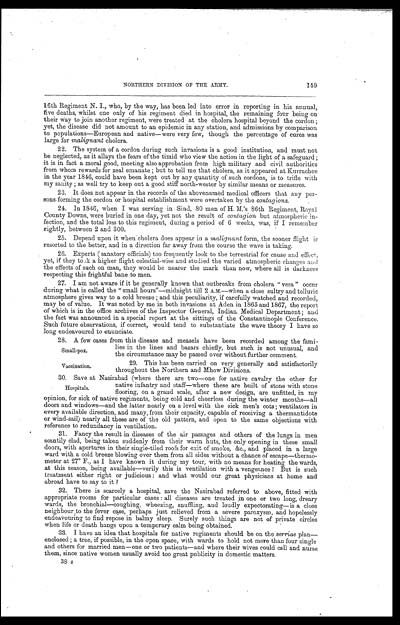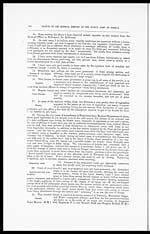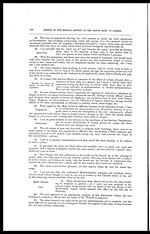Medicine - Institutions > Army health reports and medical documents > Sketch of the medical history of the native army of Bombay > Sketch of the medical history of the native army of Bombay, for the year 1872
(158) Page 149
Download files
Individual page:
Thumbnail gallery: Grid view | List view

149
NORTHERN DIVISION OF THE ARMY.
16th Regiment N. I., who, by the way, has been led into error in reporting in his annual,
five deaths, whilst one only of his regiment died in hospital, the remaining four being on
their way to join another regiment, were treated at the cholera hospital beyond the cordon;
yet, the disease did not amount to an epidemic in any station, and admissions by comparison
to populations—European and native—were very few, though the percentage of cures was
large for malignant cholera.
22. The system of a cordon during such invasions is a good institution, and must not
be neglected, as it allays the fears of the timid who view the action in the light of a safeguard;
it is in fact a moral good, meeting also approbation from high military and civil authorities
from whom rewards for zeal emanate; but to tell me that cholera, as it appeared at Kurrachee
in the year 1846, could have been kept out by any quantity of such cordons, is to trifle with
my sanity; as well try to keep out a good stiff north-wester by similar means or measures.
23. It does not appear in the records of the abovenamed medical officers that any per-
sons forming the cordon or hospital establishment were overtaken by the contagions.
24. In 1846, when I was serving in Sind, 80 men of H. M.'s 86th Regiment, Royal
County Downs, were buried in one day, yet not the result of contagion but atmospheric in-
fection, and the total loss to this regiment, during a period of 6 weeks, was, if I remember
rightly, between 2 and 300.
25. Depend upon it when cholera does appear in a malignant form, the sooner flight is
resorted to the better, and in a direction far away from the course the wave is taking.
26. Experts ( sanatory officials) too frequently look to the terrestrial for cause and effect,
yet, if they took a higher flight celestial-wise and studied the varied atmospheric changes and
the effects of such on man, they would be nearer the mark than now, where all is dankness
respecting this frightful bane to men.
27. I am not aware if it be generally known that outbreaks from cholera " vera " occur
during what is called the " small hours"—midnight till 2 A.M.—when a close sultry and telluric
atmosphere gives way to a cold breeze; and this peculiarity, if carefully watched and recorded,
may be of value. It was noted by me in both invasions at Aden in 1865 and 1867, the report
of which is in the office archives of the Inspector General, Indian Medical Department; and
the fact was announced in a special report at the sittings of the Constantinople Conference.
Such future observations, if correct, would tend to substantiate the wave theory I have so
long endeavoured to enunciate.
Small-pox.
28. A few cases from this disease and measels have been recorded among the fami-
lies in the lines and bazars chiefly, but such is not unusual, and
the circumstance may be passed over without further comment.
Vaccination.
29. This has been carried on very generally and satisfactorily
throughout the Northern and Mhow Divisions.
Hospitals.
30. Save at Nasirabad (where there are two—one for native cavalry the other for
native infantry and staff—where these are built of stone with stone
flooring, on a grand scale, after a new design, are unfitted, in my
opinion, for sick of native regiments, being cold and cheerless during the winter months—all
doors and windows—and the latter nearly on a level with the sick men's cots; ventilators in
every available direction, and many, from their capacity, capable of receiving a thermantidote
or wind-sail) nearly all these are of the old pattern, and open to the same objections with
reference to redundancy in ventilation.
31. Fancy the result in diseases of the air passages and others of the lungs in men
scantily clad, being taken suddenly from their warm huts, the only opening in these small
doors, with apertures in their single-tiled roofs for exit of smoke, &c., and placed in a large
ward with a cold breeze blowing over them from all sides without a chance of escape—thermo-
meter at 27˚ F., as I have known it during my tour, with no means for heating the wards,
at this season, being available—verily this is ventilation with a vengeance ! But is such
treatment either right or judicious: and what would our great physicians at home and
abroad have to say to it ?
32. There is scarcely a hospital, save the Nasirabad referred to above, fitted with
appropriate rooms for particular cases: all diseases are treated in one or two long, dreary
wards, the bronchial—coughing wheezing, snuffling, and loudly expectorating—is a close
neighbour to the fever case, perhaps just relieved from a severe paroxysm, and hopelessly
endeavouring to find repose in balmy sleep. Surely such things are not of private circles
when life or death hangs upon a temporary calm being obtained.
33. I have an idea that hospitals for native regiments should be on the serriae plan—
enclosed; a tree, if possible, in the open space, with wards to hold not more than four single
and others for married men—one or two patients—and where their wives could call and nurse
them, since native women usually avoid too great publicity in domestic matters.
38 s
Set display mode to: Large image | Zoom image | Transcription
Images and transcriptions on this page, including medium image downloads, may be used under the Creative Commons Attribution 4.0 International Licence unless otherwise stated. ![]()
| Permanent URL | https://digital.nls.uk/75013112 |
|---|




